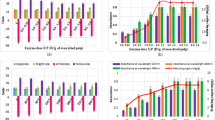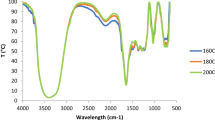Abstract
In this work, the enzymatic cocktail produced by Pleurotus djamor fungi extracted at pH of 4.8 and 5.3 was employed for castor cake solid-state treatment. Proximal, X-ray powder diffraction and scanning electron microscopy analysis of the pristine castor cake were carried out. First, Pleurotus djamor stain was inoculated in castor cake for the enzymatic production and the enzymatic activity was determined. The maximum enzymatic activity was identified at days 14 (65.9 UI/gss) and 11 (140.3 UI/gss) for the enzymatic cocktail obtained at pH 5.3 and 4.8, respectively. Then, the enzymatic cocktail obtained at the highest enzymatic activity days was employed directly over castor cake. Lignin was degraded throughout incubation time achieving a 47 and 45% decrease for the cocktail produced at pH 4.8 and 5.3, correspondingly. These results were corroborated by the SEM and XRD analysis where a higher porosity and xylan degradation were perceived throughout the enzymatic treatment.






Similar content being viewed by others
References
Balat, M. (2011). Production of bioethanol from lignocellulosic materials via the biochemical pathway: a review. Energy Conversion and Management, 52(2), 858–875. https://doi.org/10.1016/j.enconman.2010.08.013.
Limayem, A., & Ricke, S. C. (2012). Lignocellulosic biomass for bioethanol production: current perspectives, potential issues and future prospects. Progress in Energy and Combustion Science, 38(4), 449–467. https://doi.org/10.1016/j.pecs.2012.03.002.
Sarkar, N., Ghosh, S. K., Bannerjee, S., & Aikat, K. (2012). Bioethanol production from agricultural wastes: an overview. Renewable Energy, 37(1), 19–27. https://doi.org/10.1016/j.renene.2011.06.045.
Mosier, N., Wyman, C. E., Dale, B., Elander, R., Lee, Y. Y., Holtzapple, M., & Ladisch, M. (2005). Features of promising technologies for pretreatment of lignocellulosic biomass. Bioresource Technology, 96(6), 673–686. https://doi.org/10.1016/j.biortech.2004.06.025.
Zheng, Y., Zhao, J., Xu, F., & Li, Y. (2014). Pretreatment of lignocellulosic biomass for enhanced biogas production. Progress in Energy and Combustion Science, 42, 35–53. https://doi.org/10.1016/j.pecs.2014.01.001.
Talebnia, F., Karakashev, D., & Angelidaki, I. (2010). Production of bioethanol from wheat straw: an overview on pretreatment, hydrolysis and fermentation. Bioresource Technology, 101(13), 4744–4753. https://doi.org/10.1016/j.biortech.2009.11.080.
Sánchez, C. (2009). Lignocellulosic residues: biodegradation and bioconversion by fungi. Biotechnology Advances, 27(2), 185–194. https://doi.org/10.1016/j.biotechadv.2008.11.001.
Patel, S. J., Onkarappa, R., & Shobha, K. S. (2007). Comparative study of ethanol production from microbial pretreated agricultural residues. Journal of Applied Sciences and Environmental Management, 11, 137–141.
de Menezes, C. R., Silva, I. S., Pavarina, E. C., Dias, E. F. G., Dias, F. G., Grossman, M. J., & Durrant, L. R. (2009). Production of xylooligosaccharides from enzymatic hydrolysis of xylan by the white-rot fungi Pleurotus. International Biodeterioration & Biodegradation, 63(6), 673–678. https://doi.org/10.1016/j.ibiod.2009.02.008.
Marnyye, A., Velásquez, C., Mata, G., & Michel, S. J. (2002). Waste-reducing cultivation of Pleurotus ostreatus and Pleurotus pulmonarius on coffee pulp: changes in the production of some lignocellulolytic enzymes. World Journal of Microbiology and Biotechnology, 18, 201–207.
Taniguchi, M., Suzuki, H., Watanabe, D., Sakai, K., Hoshino, K., & Tanaka, T. (2005). Evaluation of pretreatment with Pleurotus ostreatus for enzymatic hydrolysis of rice straw. Journal of Bioscience and Bioengineering, 100(6), 637–643. https://doi.org/10.1263/jbb.100.637.
Yu, J., Zhang, J., He, J., Liu, Z., & Yu, Z. (2009). Combinations of mild physical or chemical pretreatment with biological pretreatment for enzymatic hydrolysis of rice hull. Bioresource Technology, 100(2), 903–908. https://doi.org/10.1016/j.biortech.2008.07.025.
Ogunniyi, D. S. (2006). Castor oil: a vital industrial raw material. Bioresource Technology, 97(9), 1086–1091. https://doi.org/10.1016/j.biortech.2005.03.028.
Ortiz-Moreno, L. (2014). Pretratamiento de los residuos lignocelulósicos provenientes de la extracción de aceite de ricino para la extracción de enzimas celulasas y xilanasas. Master’s Thesis, (pp. 52–53). México: Benemérita Universidad Autónoma de Puebla.
Official Methods of Analysis of AOAC International. (2006). 25th ed. Association of Official Analytical Chemists: Arlington.
Van Soest, P. J., Robertson, J. B., & Lewis, B. A. (1991). Methods for dietary fiber, neutral detergent fiber and nonstarch polysaccharides in relation to animal nutrition. Journal of Dairy Science, 74(10), 3583–3597. https://doi.org/10.3168/jds.S0022-0302(91)78551-2.
Terinte, N., Ibbett, R., & Schuster, K. C. (2011). Overview on native cellulose and microcrystalline cellulose I structure studied by x-ray diffraction (WAXD): comparison between measurement techniques. Lenzinger Berichte, 89, 118–131.
Mikiashvili, N., Wasser, S. P., Nevo, E., & Elisashvili, V. (2006). Effects of carbon and nitrogen sources on Pleurotus ostreatus ligninolytic enzyme activity. World Journal of Microbiology and Biotechnology, 22(9), 999–1002. https://doi.org/10.1007/s11274-006-9132-6.
Cianchetta, S., Galletti, S., Burzi, P. L., & Cerato, C. (2010). A novel microplate-based screening strategy to assess the cellulolytic potential of Trichoderma strains. Biotechnology and Bioengineering, 107(3), 461–468. https://doi.org/10.1002/bit.22816.
Miller, G. L. (1959). Use of dinitrosalicylic acid reagent for determination of reducing sugar. Analytical Chemistry, 31(3), 426–428. https://doi.org/10.1021/ac60147a030.
Desai, D. I., & Iyer, B. D. (2016). Biodeinking of old newspaper pulp using a cellulase-free xylanase preparation of Aspergillus niger DX-23. Biocatalysis and Agricultural Biotechnology, 5, 78–85. https://doi.org/10.1016/j.bcab.2015.11.001.
Bonatti, M., Karnopp, A. P., Soares, H. M., & Furlan, S. A. (2004). Evaluation of Pleurotus ostreatus and Pleurotus sajor-caju nutritional characteristics when cultivated in different lignocellulosic wastes. Food Chemistry, 88(3), 425–428. https://doi.org/10.1016/j.foodchem.2004.01.050.
Herculano, P. N., Lima, D. M. M., Fernandes, M. J. S., Neves, R. P., Souza-Motta, C. M., & Porto, A. L. (2011). Isolation of cellulolytic fungi from waste of castor (Ricinus Communis L.) Current Microbiology, 62(5), 1416–1422. https://doi.org/10.1007/s00284-011-9879-3.
Sun, Y., & Cheng, J. (2002). Hydrolysis of lignocellulosic materials for ethanol production: a review. Bioresource Technology, 83(1), 1–11. https://doi.org/10.1016/S0960-8524(01)00212-7.
Lacerda, R. S., Makishi, G. L. A., Chambib, H. N. M., Bittante, Q. B., Gomide, C. A., Costa, P. A., & Sobral, P. J. A. (2014). Castor bean (Ricinus communis) cake protein extraction by alkaline solubilization: definition of process parameters. Chemical Engineering Transactions, 37, 775–780.
Martin, C., Moure, A., Martin, G., Carrillo, E., Dominguez, H., & Parajó, J. (2010). Fractional characterisation of jatropha, neem, moringa, trisperma, castor and candlenut seeds as potential feedstocks for biodiesel production in Cuba. Biomass & Bioenergy, 34(4), 533–538. https://doi.org/10.1016/j.biombioe.2009.12.019.
Annongu, A. A., & Joseph, J. K. (2008). Proximate analysis of castor seeds and cake. Journal of Applied Sciences and Environmental Management, 12, 39–41.
Manthey, F. A., Hareland, G. A., & Huseby, D. J. (1999). Soluble and insoluble dietary fiber content and composition of oat. Cereal Chemistry, 76(3), 417–420. https://doi.org/10.1094/CCHEM.1999.76.3.417.
Agbor, V. B., Cicek, N., Sparling, R., Berlin, A., & Levin, D. B. (2011). Biomass pretreatment: fundamentals toward application. Biotechnology Advances, 29(6), 675–685. https://doi.org/10.1016/j.biotechadv.2011.05.005.
Chen, W., Zhong, L., Peng, X., Wang, K., Chen, Z., & Sun, R. (2014). Xylan-type hemicellulose supported palladium nanoparticles: a highly efficient and reusable catalyst for the carbon-carbon coupling reactions. Catalysis Science & Technology, 4(5), 1426–1435. https://doi.org/10.1039/C3CY00933E.
Suárez-García, F., Martínez-Alonzo, A., Fernández Llorente, M., & Tascón, J. M. D. (2002). Inorganic matter characterization in vegetable biomass feedstocks. Fuel, 81(9), 1161–1169. https://doi.org/10.1016/S0016-2361(02)00026-1.
Clixoo, (2010). Comprehensive castor oil report: A report on castor oil & castor oil derivatives. Tamilnadu, India. Available from http://www.castoroil.in.
Cheng, G., Varanasi, P., Li, C., Liu, H., Melnichenko, Y. B., Simmons, B. A., Kent, M. S., & Singh, S. (2011). Transition of cellulose crystalline structure and surface morphology of biomass as a function of ionic liquid pretreatment and its relation to enzymatic hydrolysis. Biomacromolecules, 12(4), 933–941. https://doi.org/10.1021/bm101240z.
Perea-Flores, M. J., Chanona-Pérez, J. J., Garibay-Febles, V., Calderón-Dominguez, G., Terrés-Rojas, E., Mendoza-Pérez, J. A., & Herrera-Bucio, R. (2011). Microscopy techniques and image analysis for evaluation of some chemical and physical properties and morphological features for seeds of the castor oil plant (Ricinus communis). Industrial Crops and Products, 34(1), 1057–1065. https://doi.org/10.1016/j.indcrop.2011.03.015.
Herculano, P. N., Porto, T. S., Moreira, K. A., Pinto, G. A., Souza-Motta, C. M., & Porto, A. L. F. (2011). Cellulase production by Aspergillus japonicus URM5620 using waste from castor bean (Ricinus communis L.) under solid-state fermentation. Applied Biochemistry and Biotechnology, 165(3-4), 1057–1067. https://doi.org/10.1007/s12010-011-9321-0.
Howard, R. L., Abotsi, E., Jansen van Ressburg, E. L., & Howard, S. (2013). Lignocellulose biotechology: issues of biocenversion and enzyme production. African Journal of Biotechnology, 2, 602–619.
Wan, C., & Li, Y. (2012). Fungal pretreatment of lignocellulosic biomass. Biotechnology Advances, 30(6), 1447–1457. https://doi.org/10.1016/j.biotechadv.2012.03.003.
Elisashvili, V., Penninckx, M., Kachlishvili, E., Tsiklauri, N., Metreveli, E., Kharziani, T., & Kvesitadze, G. (2008). Lentinus edodes and Pleurotus species lignocellulolytic enzymes activity in submerged and solid-state fermentation of lignocellulosic wastes of different composition. Bioresource Technology, 99(3), 457–462. https://doi.org/10.1016/j.biortech.2007.01.011.
Xu, F., Shi, Y.-C., & Wang, D. (2013). X-ray scattering studies of lignocellulosic biomass: a review. Carbohydrate Polymers, 94(2), 904–917. https://doi.org/10.1016/j.carbpol.2013.02.008.
Sánchez-Cantú, M., Pérez-Díaz, L. M., Tepale-Ochoa, N., González-Coronel, V. J., Ramos-Cassellis, M. E., Machorro-Aguirre, D., & Valente, J. S. (2013). Green synthesis of hydrocalumite-type compounds and their evaluation in the transesterification of castor bean oil and methanol. Fuel, 110, 23–31. https://doi.org/10.1016/j.fuel.2012.06.078.
Iglesias, I., García-Romero, E., & Acosta, A. (2014). Influence of dolomite microcrystals on the technological properties of Santa Cruz de Mudela clays used for building ceramics. Applied Clay Science, 102, 261–267. https://doi.org/10.1016/j.clay.2014.10.009.
Acknowledgements
Authors thank BUAP-CUVyTT for the help given in catalysts’ characterization; L. Ortíz-Moreno thanks Conacyt for the scholarship granted.
Author information
Authors and Affiliations
Corresponding author
Ethics declarations
Conflict of Interest
The authors declare that they have no conflict of interest.
Rights and permissions
About this article
Cite this article
Sánchez-Cantú, M., Ortiz-Moreno, L., Ramos-Cassellis, M.E. et al. Solid-State Treatment of Castor Cake Employing the Enzymatic Cocktail Produced from Pleurotus djamor Fungi. Appl Biochem Biotechnol 185, 434–449 (2018). https://doi.org/10.1007/s12010-017-2656-4
Received:
Accepted:
Published:
Issue Date:
DOI: https://doi.org/10.1007/s12010-017-2656-4




